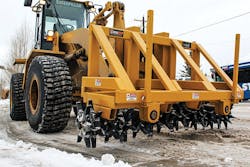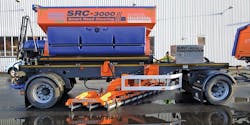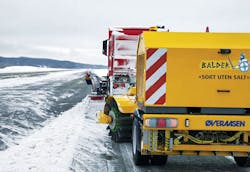Mechanical snow removal innovations offer alternatives to deicers
The American driving public has high expectations of road conditions during winter months, and state and local transportation agencies work diligently to provide motorists, emergency services, and commercial traffic with safe and passable roads.
Since the 1960s, this has led to a steady increase in the quantity of road salt applied to roads—now totaling around 25 million tons each year.
With more awareness of the environmental impacts of traditional deicers—such as elevated chloride levels in surface and groundwater—transportation agencies have been proactively making changes to their winter maintenance operations over the last decade. While one approach has been to consider alternative deicing products, a second approach has been to implement improved methods that reduce the amount of deicer applied.
Sponsored by the Clear Roads Research Program, Alternative Methods for Deicing examines the many ways state and local transportation agencies are working to reduce chloride use in their winter maintenance practices. After conducting an extensive literature review, practitioner survey, and interviews, the research team, led by principal investigator Laura Fay of the Western Transportation Institute, developed case studies and recommendations as a resource for road agencies.
“There is no ‘one size fits all’ solution to reducing chloride use, so the case studies showcase a range of options,” said Fay. “There are low-cost options like ensuring that staff are applying the right amount of product to the right place at the right time, as well as larger scale investments, such as the creation and use of blended liquid deicers. What we found most intriguing, however, is that there are a number of recent innovations and improved methods for mechanical snow removal.”
Mechanical snow removal is the plowing or scraping of snow or ice from the roadway. Agencies are improving their mechanical snow removal methods by using advanced plow blades that are more effective for different conditions or roadway compositions. Not only are these new blades more cost-effective, they limit damage to the roadway, roadway markings, and other obstacles, as well as reduce the need for chemical deicers. Some of the most promising innovations are icebreakers, squeegee blades, and brooms.
Icebreakers
Icebreakers, or penetrating drums, use metal spikes or blades to break the packed snow or ice bonded with the pavement into smaller pieces that can be plowed off the roadway. The research team found three or four manufacturers that are producing or developing this technology, and several state departments of transportation that have tested it.
Both the Utah Department of Transportation and the Minnesota Department of Transportation have successfully tested the Raiko T-15, finding that it cut through ice pack well without causing damage to asphalt and concrete pavements, leading to reduced chloride applications. An icebreaker built specifically for the runways at Fairbanks International Airport (FAI), called the Yeti, won an award for innovative design. The Alaska Department of Transportation started testing ice breaking equipment to manage packed snow and ice buildup on pavements after freezing rain events, and currently uses two Raikos and two Arctic Sharks to improve pavement conditions. The agency reported that breaking up the ice allows deicers to penetrate down to the pavement surface, further breaking the bond between the snow/ice and pavement. In extreme icing events, this has the added benefit of increasing friction on the surface.
The Alaska DOT shared several key lessons for icebreaker operators:
- The ideal driving speed for running an icebreaker is 15-17 mph.
- Operators are advised to keep turning to a minimum.
- Operators are advised to use extreme caution when crossing railroads and bridge expansion joints.
- Close monitoring of down-pressure is crucial to avoiding damage to the pavement on very thick ice pack.
Rubber or Squeegee Blades
Squeegee blades are often made of rubber or plastic. This type of blade is useful for removing slush or light snow from a roadway. Squeegee blades cause less damage to roadway markings and are effective on brick or cobblestone. Squeegee blades can also be used in combination with a front cutting-edge snowplow blade to remove excess liquids or snow left behind.
Agencies in the neighboring states of Iowa and Illinois have started using multi-edge snowplow blades with a three-blade configuration that includes a main plow blade, a scarifying blade to break up hard-packed snow, and a squeegee blade to clear slush. Snowplow operators can raise or lower each blade depending on the conditions. In field tests, the multi-edge snowplow blades cleared more snow and ice in a single pass than a traditional snowplow blade. The Iowa Department of Transportation found that the multi-edge plow blade removed 20-25% more material than a traditional plow blade.
The South Dakota Department of Transportation tested a two-blade configuration—a carbine-tipped plow blade with a squeegee blade mounted behind. This method reduced salt applications by 50%, saving a significant amount of deicer and money.
The Norwegian Public Roads Administration (NPRA) uses three diagonally mounted slush slats (read: rubber blades) on a unit towed behind a snowplow. According to the agency, this configuration is particularly effective at removing light snow, slush, and water from the road surface, while reducing the amount of chloride needed to treat the road.
Brooms and Sweepers
Airports have used brooms to remove snow from runways for many years; recently, other agencies have started using them on sidewalks and roadways. As a result, some valuable lessons learned are emerging. For example, snow sweepers do not work as well as plow blades on wet snow and will not remove packed snow or ice from a roadway. However, brooms have shown good results on roads with drier snow; they reduce the amount of deicer needed and achieve bare pavement quickly.
At Montana State University, the maintenance agency uses brooms instead of plows on campus roads when there is less than 6 in. of low-density snow. Staff members report that they can return the roads to clear and dry conditions more quickly, using less deicer.
In Norway, the NPRA needed to limit salt applications on two roads near a critical drinking water source. Contractors started using sweepers in these locations; as a result, they were immediately able to reduce salt application by 25-30% and achieve better road conditions. As guidance for others, the NPRA documented numerous advantages and disadvantages of using brooms, in comparison to their standard winter maintenance operations:
Advantages:
- The road is much cleaner after clearing the snow.
- Less salt is required.
- Less slush on the road, which improves road safety.
- The road dries faster.
- A dry road surface reduces the wear on studded tires.
- A dry road reduces the risk of ice at low temperatures.
- Less need for gritting (re: sanding) when temperatures are too low for salt application.
- Less spray on windshields and signs along the road.
- Road markings are more visible.
- Fewer complaints from road users.
Disadvantages:
- More expensive to buy and use.
- Requires more training for snowplow drivers.
- Can only apply brine, not dry or pre-wetted salt. This can be a disadvantage at low temperatures.
- Hard to drive the snowplow close enough to railings and obstacles on the right side.
- Equipment is advanced and demanding.
- May cause a lot of drifting, dry snow behind the device.
- Long vehicle combinations have limited maneuverability.
Resources are out there
Winter maintenance operations are a challenging responsibility, especially for state and local transportation agencies striving to balance efficiency, cost, and environmental sustainability. To reduce the use of chloride-based deicers in snow and ice operations, agencies need a range of options to adapt to specific locations and weather conditions, including the use of mechanical snow removal. Alternative Methods for Deicing provides resources and recommendations to help agencies get started and make informed decisions while planning their equipment, technology, and material needs. As project co-champion Joe Bucci of the Rhode Island Department of Transportation noted, “If you’re involved in winter maintenance and you don’t come away with something useful from this project, I would be surprised.”
To learn more about the mechanical snow removal methods discussed here or other methods to reduce chloride use in winter maintenance operations, the full report is available at: https://clearroads.org/project/18-05/.
-------------------------------
ABOUT THE AUTHOR:
Fay is Senior Research Scientist and manages the Cold Climate Operations & Systems research group at the Western Transportation Institute at Montana State University. Clouser is a Research Associate with the Western Transportation Institute at Montana State University. Little is a Communications Specialist for the Western Transportation Institute at Montana State University.




